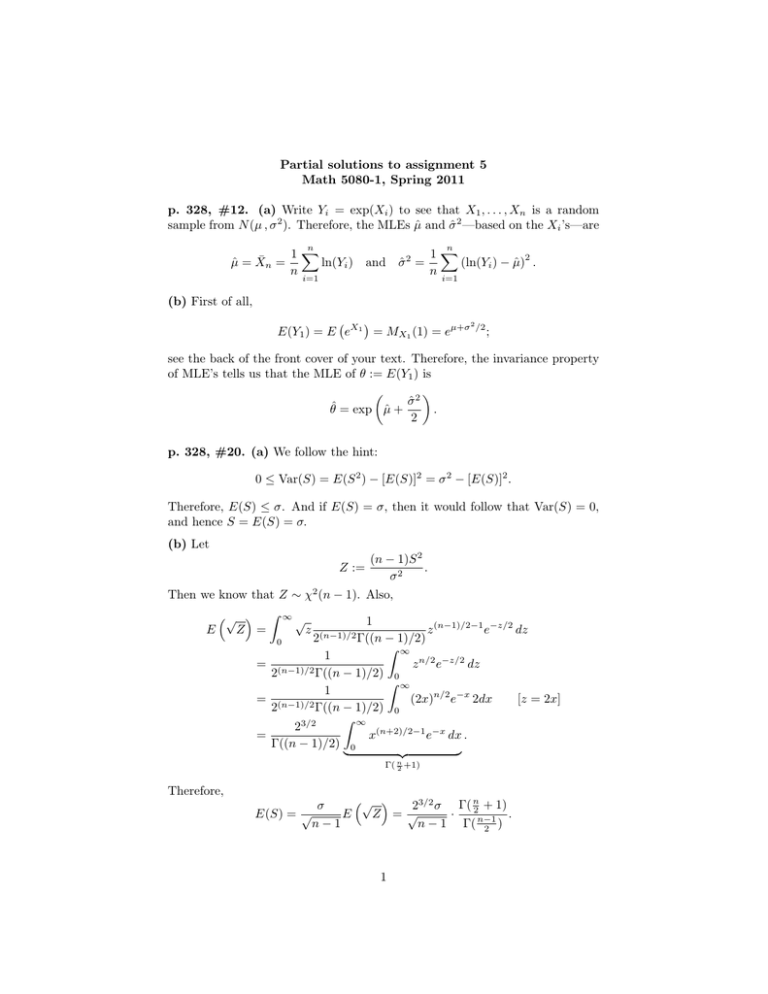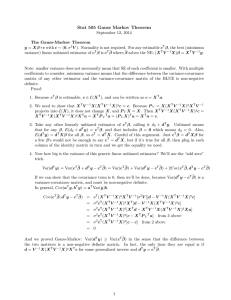Partial solutions to assignment 5 Math 5080-1, Spring 2011 = exp(X
advertisement

Partial solutions to assignment 5
Math 5080-1, Spring 2011
p. 328, #12. (a) Write Yi = exp(Xi ) to see that X1 , . . . , Xn is a random
sample from N (µ , σ 2 ). Therefore, the MLEs µ̂ and σ̂ 2 —based on the Xi ’s—are
n
µ̂ = X̄n =
1X
ln(Yi )
n i=1
n
and σ̂ 2 =
1X
2
(ln(Yi ) − µ̂) .
n i=1
(b) First of all,
2
E(Y1 ) = E eX1 = MX1 (1) = eµ+σ /2 ;
see the back of the front cover of your text. Therefore, the invariance property
of MLE’s tells us that the MLE of θ := E(Y1 ) is
σ̂ 2
.
θ̂ = exp µ̂ +
2
p. 328, #20. (a) We follow the hint:
0 ≤ Var(S) = E(S 2 ) − [E(S)]2 = σ 2 − [E(S)]2 .
Therefore, E(S) ≤ σ. And if E(S) = σ, then it would follow that Var(S) = 0,
and hence S = E(S) = σ.
(b) Let
Z :=
(n − 1)S 2
.
σ2
Then we know that Z ∼ χ2 (n − 1). Also,
√ Z ∞ √
1
E
Z =
z (n−1)/2
z (n−1)/2−1 e−z/2 dz
2
Γ((n − 1)/2)
0
Z ∞
1
= (n−1)/2
z n/2 e−z/2 dz
2
Γ((n − 1)/2) 0
Z ∞
1
= (n−1)/2
(2x)n/2 e−x 2dx
[z = 2x]
2
Γ((n − 1)/2) 0
Z
∞
23/2
=
x(n+2)/2−1 e−x dx .
Γ((n − 1)/2) 0
|
{z
}
Γ( n
2 +1)
Therefore,
E(S) = √
√ σ
23/2 σ Γ( n2 + 1)
E
Z =√
·
.
n−1
n − 1 Γ( n−1
2 )
1
Therefore, the answer is
√
n − 1 Γ( n−1
2 )
.
n
3/2
2 Γ( 2 + 1)
c=
(c) First of all, we need to know what the 95% percentile q of the distribution
of X is: We wish to find q such that P {X ≤ q} = 0.95; therefore,
q−µ
q−µ
0.95 = Φ
⇒
= 1.65 ⇒ q = µ + 1.65σ.
σ
σ
Therefore, an unbiased estimator of q is
q̂ = X̄ + 1.65cS,
where c is from the previous part.
p. 328, #21.
X1 , . . . , Xn is
(a) First of all, the common probability mass function of
f (x , p) = pI{x = 1} + (1 − p)I{x = 0}.
Therefore,
"
E
2 #
2
2
∂
∂
∂
ln f (X, p)
=p
ln p + (1 − p)
ln(1 − p)
∂p
∂p
∂p
=
1
1
1
+
=
.
p 1−p
p(1 − p)
By the Cramér–Rao lower bound, if T is unbiased for τ (p) = p then
Var(T ) ≥
1
p(1 − p)
=
.
n/p(1 − p)
n
Because X̄ achieves this bound with an equality, it follows that it is UMVUE
for p. This answers part (c).
(b) Now τ (p) = p(1 − p), therefore τ 0 (p) = 1 − 2p and hence if T is unbiased
for p(1 − p), then
Var(T ) ≥
(1 − 2p)2
(1 − 2p)2 p(1 − p)
=
.
n/p(1 − p)
n
p. 328, #23. (a) The mean is known. Therefore, the MLE is
n
θ̂ =
1X 2
X .
n i=1 i
A quick computation shows that θ̂ is unbiased for θ [the variance].
(b) Because
Var(θ̂) =
Var(X12 )
,
n
2
we need the variance of X12 . But X12 = θZ 2 , where Z ∼ N (0 , 1). Therefore, the
variance of X12 is θ2 times the variance of a χ2 (1); i.e., 2θ2 [see the front cover
of your text].
Now,
"
2 #
∂
∂
= Var
ln f (X1 , θ)
ln f (X1 , θ)
(recall mean is zero)
E
∂θ
∂θ
√
X 2 ∂
− ln
2πθ − 1
= Var
∂θ
2θ
2
2
X1
Var(X1 )
2θ2
1
= Var
=
=
= 2.
2θ2
4θ4
θ4
2θ
Therefore, any unbiased estimator T of θ satisfies
Var(T ) ≥
1
2θ2
=
.
2
n/(2θ )
n
The rightmost term is Var(θ̂); therefore, θ̂ is UMVUE of θ.
p. 328, #24. (a) We compute
E(θ̂) =
∞
X
e−i
i=0
∞
X
e−µ µi
(µ/e)i
= e−µ
i!
i!
i=0
−1
= e−µ · eµ/e = e−µ[1−e ] .
Therefore, θ̂ is biased for e−µ .
(b) Because u(x) = I{x = 0},
E(θ̃) =
∞
X
u(i)
i=0
e−µ µi
= e−µ .
i!
(c) First of all,
E(θ̂2 ) =
∞
X
i=0
e−2i
−2
e−µ µi
= e−µ[1−e ] .
i!
Therefore,
−2
−1
Var(θ̂) = e−µ[1−e ] − e−2µ[1−e ] .
Also, because θ̃ and its square are equal,
h
i2
Var(θ̃) = E(θ̃) − E(θ̃) = e−µ − e−2µ .
When µ = 1,
Var(θ̃) = e−1 − e−2 ≈ 0.2325,
−2
−1
Var(θ̂) = e−[1−e ] − e−2[1−e ] ≈ 0.1388.
3
Also
Bias(θ̃) = 0,
−1
Bias(θ̂) = e−[1−e ] − e−1 ≈ 0.164.
Therefore,
MSE(θ̃) ≈ 0.2325,
MSE(θ̂) ≈ 0.1642 + 0.1388 ≈ 0.165.
Therefore, θ̂ does a better job, although it is biased.
When µ = 2,
Var(θ̃) = e−2 − e−4 ≈ 0.117,
Also
Bias(θ̃) = 0,
−2
−1
Var(θ̂) = e−2[1−e ] − e−4[1−e ] ≈ 0.098.
−1
Bias(θ̂) = e−2[1−e ] − e−2 ≈ 0.147.
Therefore,
MSE(θ̃) ≈ 0.117,
MSE(θ̂) ≈ 0.1472 + 0.098 ≈ 0.119.
Therefore, for µ = 2, θ̃ does a better job than θ̂ [the roles are reversed!]. This is
an example where we have two estimators, neither of which is better than the
other for all possible choices of the unknown parameter µ.
4







